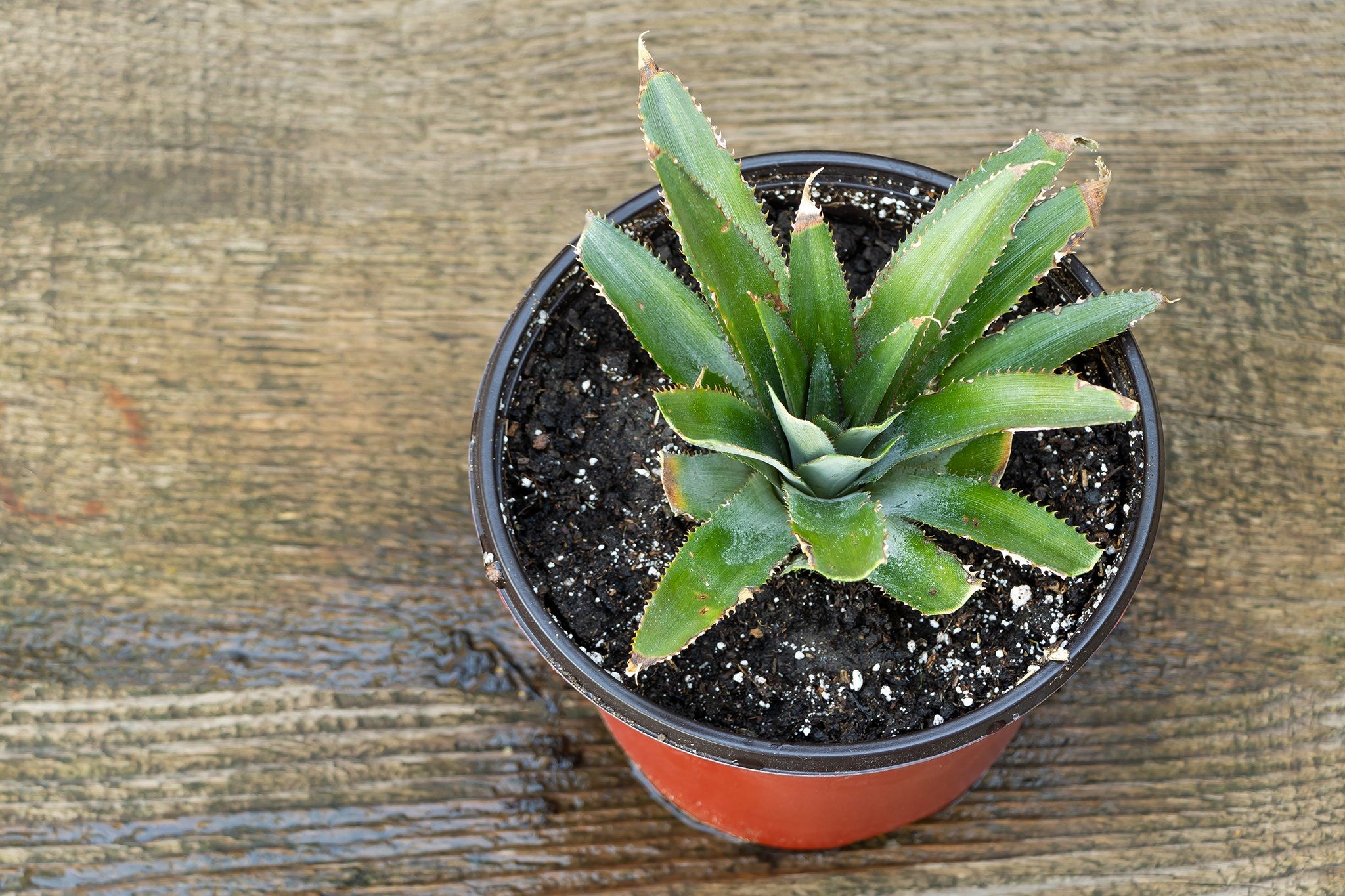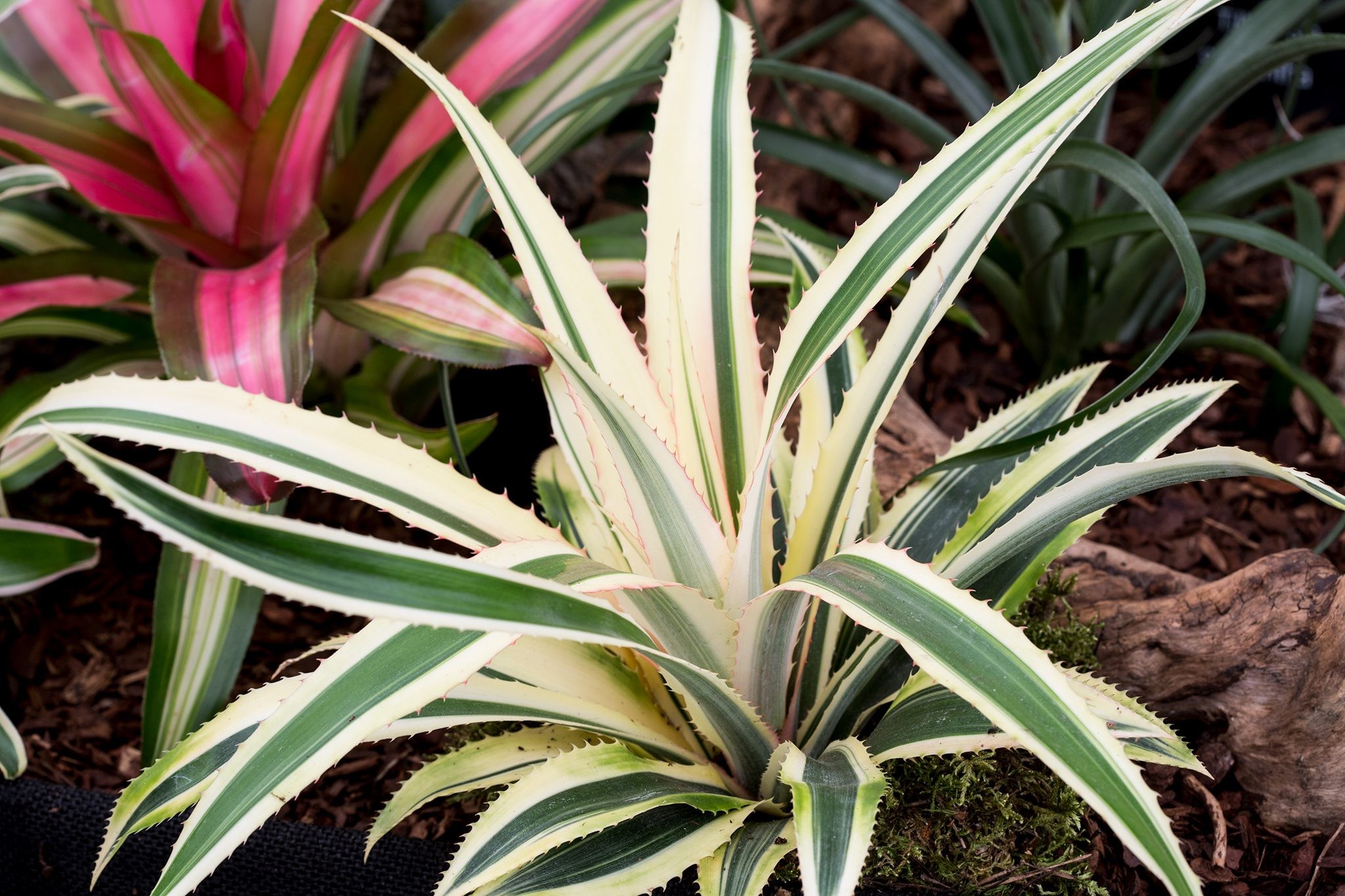Caring for a pineapple plant is an enjoyable and rewarding experience. This guide from CARS.EDU.VN provides everything you need to know about cultivating these unique tropical plants, ensuring healthy growth and even the potential for homegrown fruit. By understanding their needs and providing the right environment, you can enjoy the beauty and novelty of a pineapple plant in your home. Learn more about plant care tips, bromeliad family secrets, and tropical plant cultivation.
1. Understanding the Pineapple Plant
The pineapple plant, scientifically known as Ananas comosus, belongs to the bromeliad family, a group celebrated for their resilience and adaptability. Native to tropical and subtropical regions, these plants are known for their distinctive appearance and the delicious fruit they produce. Interestingly, pineapples are not your average fruit; they are multiple fruits formed from the fusion of individual fruit-producing flowers.
1.1. Pineapple Plant Biology
Understanding the life cycle of a pineapple plant can help you provide the right care. In their natural habitat, pineapples grow on the ground and are pollinated by hummingbirds. As bromeliads, they have a unique life cycle: after flowering and producing a fruit, the main plant begins to decline. However, this isn’t the end. New, small plants, often referred to as “pups” or “offsets,” emerge at the base, ready to be potted and grown into new plants. This natural propagation method allows you to continuously enjoy pineapple plants.
1.2. Debunking Myths: Pineapples and Snoring
You might have heard that placing a pineapple plant near your bed can reduce snoring due to its nighttime oxygen production. While it’s true that pineapple plants, like many houseplants, purify the air, there’s currently no scientific evidence to support the anti-snoring claim. However, the air-purifying qualities of a pineapple plant can still contribute to a healthier and more pleasant sleeping environment.
2. Creating the Ideal Environment for Your Pineapple Plant
To ensure your pineapple plant thrives, it’s essential to replicate its natural tropical habitat as closely as possible. This involves careful consideration of factors like light, temperature, and humidity.
2.1. Light Requirements
Pineapple plants love bright light. A spot that receives plenty of sunlight, such as a conservatory, a heated greenhouse, or a bright windowsill, is ideal. While they can tolerate some direct sunlight, too much can lead to leaf scorch. To prevent uneven growth, rotate your plant regularly, ensuring all sides receive adequate light.
2.2. Temperature and Humidity
Warmth is key for pineapple plants. Aim for a minimum temperature of 60°F (16°C), but the warmer, the better. During summer, you can move your pineapple plant outdoors to bask in the high light levels, but remember to bring it back inside as temperatures drop in the fall. Maintaining adequate humidity is also important. If the air is too dry, consider using a humidifier or placing the plant on a tray filled with pebbles and water to increase moisture around the plant.
2.3. Soil and Potting
Pineapple plants aren’t particularly long-lived in pots, so they usually do fine in their original containers. However, if you choose to repot or are starting a new plant, use a well-draining mix of orchid compost and peat-free multi-purpose compost. This combination provides the necessary nutrients while ensuring good drainage, which is vital to prevent root rot.
3. Watering and Fertilizing Your Pineapple Plant
Proper watering and fertilization are essential to keep your pineapple plant healthy and encourage growth.
3.1. Watering Schedule
During spring and summer, water your pineapple plant when the top few centimeters of the compost feel dry. Always allow excess water to drain away to prevent waterlogging. In winter, reduce watering to keep the soil barely moist. Remember, consistency is key, but it’s always better to underwater than overwater.
3.2. Fertilizing Routine
Feed your pineapple plant every two weeks during spring and summer with a weak liquid fertilizer. In winter, reduce feeding to once a month. A balanced fertilizer will provide the necessary nutrients for healthy growth and fruit production. Dilute the fertilizer to half strength to avoid burning the roots.
4. Propagating Your Own Pineapple Plants
One of the most rewarding aspects of growing pineapple plants is propagation. There are two main methods: using offsets (pups) or the fruit’s crown.
4.1. Propagating from Offsets (Pups)
After your pineapple plant fruits, it will start to die back, but it will also produce baby plants (offsets) at its base. To propagate from offsets, carefully sever them from the mother plant using a clean, sharp knife. Ensure each offset has some roots attached. Pot each offset in a small pot with the same compost mix used for the parent plant. Water well and keep in a warm, bright location.
4.2. Propagating from the Fruit Crown
You can also grow a pineapple plant from the fruit’s crown. Cut off the spiky top of a store-bought pineapple and remove the lower leaves to reveal a short stem. Allow the stem to dry out for a day or two to prevent rot. Then, place it in a pot of compost, water it well, and wait for roots to develop. This method is a fun and easy way to start a new pineapple plant from something you would otherwise discard.
Propagating pineapple plants through potted up offsets.
5. Common Problems and Solutions
Like any plant, pineapples can encounter certain problems. Knowing how to identify and address these issues can help keep your plant healthy.
5.1. Dying Back After Fruiting
It’s normal for a pineapple plant to die back after it has fruited. However, always check for new baby plants (offsets) at the base, as these can be propagated into new plants.
5.2. Lack of Flowering or Fruiting
If your pineapple plant isn’t producing a flower spike or fruit, patience is key. Pineapple plants typically flower when they’re around two years old and produce fruit about six months later. Ensure your plant is receiving enough light and nutrients to encourage flowering.
5.3. Yellow Leaves and Blackening at the Base
Yellow leaves and blackening at the base are often signs of overwatering. This can lead to root rot, which can be fatal. If you notice these symptoms, remove the plant from its container and inspect the roots. Trim away any affected roots and repot the plant in fresh compost. Reduce watering and ensure the soil is moist but not soggy.
5.4. Pests and Diseases
Pineapple plants can be susceptible to pests like mealybugs and scale insects. These pests can be removed by wiping the leaves with cotton wool soaked in organic insecticide based on plant oils or fatty acids. You may also encounter fungus gnats, which are attracted to moist soil. To combat these, allow the compost to dry out between waterings.
6. Choosing the Right Pineapple Variety
While Ananas comosus is the most common variety, several cultivars offer unique characteristics and appearances.
6.1. Variegated Pineapple (Ananas comosus var. variegatus)
This variety features dark green leaves with broad cream stripes and spiny edges. It produces cone-like clusters of purple flowers followed by bitter red fruit. It typically grows to a height of 60cm and a spread of 90cm.
6.2. ‘Champaca’ (Ananas comosus ‘Champaca’)
‘Champaca’ is an evergreen perennial with rosettes of deep green, spiny, lance-shaped leaves. It produces dense spikes of tubular purple flowers with reddish bracts in summer, followed by small, ornamental fruit. It typically grows to 50cm in both height and spread.
6.3. ‘Corona’ (Ananas comosus ‘Corona’)
‘Corona’ is a pygmy or dwarf pineapple that hails from Brazil. It has silver foliage and miniature, inedible fruits. It typically grows to 40cm in both height and spread.
6.4. ‘Amigo’ (Ananas comos ‘Amigo’)
‘Amigo’ is another pygmy or dwarf pineapple with fresh green foliage and small, inedible fruits. It typically grows to 40cm in both height and spread.
The Ananas comosus var. variegatus, a visually striking variety of pineapple plant.
7. Shopping for Your Pineapple Plant
When buying a pineapple plant, keep a few things in mind to ensure you choose a healthy and vibrant specimen.
7.1. Availability
Pineapple plants are popular and are mainly exported from South America. Availability can vary depending on the season and your location. Check your local supermarket or garden center, or buy from a specialist retailer online.
7.2. What to Look For
Your plant may be sold with a small fruit already forming. If it hasn’t yet formed a fruit, be patient – it will form a flower that will in turn become a fruit. Remember that your plant will die back once the fruit drops off, but it should produce new baby plants at the base which can be potted up and grown on as new plants.
7.3. Online Retailers
Several online retailers offer pineapple plants. These include:
- Thompson & Morgan
- Bloom Box Club
- You Garden
8. Advanced Tips for Pineapple Plant Care
For those looking to take their pineapple plant care to the next level, consider these advanced tips.
8.1. Monitoring Soil pH
Pineapple plants thrive in slightly acidic soil with a pH between 4.5 and 6.5. Regularly testing the soil pH can help you ensure optimal conditions for growth. You can purchase a soil pH testing kit from most garden centers. If the soil is too alkaline, you can amend it with sulfur or peat moss to lower the pH.
8.2. Enhancing Air Circulation
Good air circulation is essential to prevent fungal diseases and pests. Ensure your pineapple plant is not overcrowded and has adequate space around it. You can also use a small fan to improve air circulation, especially in humid environments.
8.3. Pruning Techniques
Regular pruning can help maintain the shape and health of your pineapple plant. Remove any dead or damaged leaves with clean, sharp scissors or pruning shears. This will not only improve the plant’s appearance but also prevent the spread of disease.
9. The Joy of Harvesting Your Own Pineapple
One of the greatest rewards of growing a pineapple plant is harvesting your own fruit. Here’s how to know when your pineapple is ready and how to harvest it.
9.1. Signs of Ripeness
A ripe pineapple will turn orange-yellow in color and have a sweet smell. The fruit should also feel slightly soft to the touch. These are all indicators that your pineapple is ready for harvest.
9.2. Harvesting Techniques
To harvest your pineapple, use a sharp knife to cut the fruit from the plant. Leave a small portion of the stem attached to the fruit. Once harvested, you can enjoy your homegrown pineapple in a variety of ways, from eating it fresh to using it in recipes.
9.3. Post-Harvest Care
After harvesting the pineapple, continue to care for the plant as usual. It will eventually die back, but it should produce new offsets that you can propagate into new plants.
10. Creative Ways to Display Your Pineapple Plant
Pineapple plants can add a touch of tropical beauty to any home. Here are some creative ways to display your plant.
10.1. Decorative Pots
Choose decorative pots that complement your home decor. Terra cotta pots, ceramic pots, and even woven baskets can add a stylish touch to your pineapple plant display.
10.2. Grouping with Other Plants
Create a tropical oasis by grouping your pineapple plant with other tropical plants, such as ferns, orchids, and bromeliads. This will not only enhance the visual appeal of your display but also create a more humid environment that benefits all the plants.
10.3. Hanging Baskets
For a unique and eye-catching display, consider growing your pineapple plant in a hanging basket. This will allow the plant to cascade and create a stunning visual effect.
11. Pineapple Plant Care Calendar
To help you stay organized, here’s a seasonal care calendar for your pineapple plant.
| Season | Care Tasks |
|---|---|
| Spring | Increase watering and begin fertilizing every two weeks. Repot if necessary. |
| Summer | Move outdoors if desired. Continue watering and fertilizing. Monitor for pests. |
| Fall | Bring indoors as temperatures drop. Reduce watering and fertilizing. |
| Winter | Keep soil barely moist. Fertilize once a month. Protect from cold drafts. |


12. The Environmental Benefits of Growing Pineapple Plants
Growing pineapple plants not only adds beauty to your home but also offers several environmental benefits.
12.1. Air Purification
Like many houseplants, pineapple plants purify the air by removing toxins and releasing oxygen. This can improve the air quality in your home and create a healthier living environment.
12.2. Carbon Sequestration
Pineapple plants absorb carbon dioxide from the atmosphere, helping to reduce greenhouse gases and combat climate change.
12.3. Biodiversity
By growing a variety of plants, including pineapple plants, you can contribute to biodiversity and create a more sustainable ecosystem in your home and garden.
13. Pineapple Plants in Interior Design
Pineapple plants are a versatile addition to any interior design scheme. Here are some tips on how to incorporate them into your home decor.
13.1. Tropical Themes
Use pineapple plants to create a tropical theme in your home. Pair them with rattan furniture, bright colors, and other tropical plants to create a relaxing and exotic atmosphere.
13.2. Modern Decor
Pineapple plants can also complement modern decor. Choose sleek, minimalist pots and place them in strategic locations to add a touch of greenery and sophistication to your home.
13.3. Eclectic Style
For an eclectic look, mix and match different pots, plants, and accessories. Pineapple plants can add a unique and unexpected element to your eclectic style.
14. Pineapple Plant FAQs
Here are some frequently asked questions about pineapple plant care.
14.1. How long does it take for a pineapple plant to produce fruit?
A pineapple plant typically takes around two years to flower and another six months to produce fruit.
14.2. Can I grow a pineapple plant from a store-bought pineapple?
Yes, you can grow a pineapple plant from the crown of a store-bought pineapple.
14.3. How often should I water my pineapple plant?
Water your pineapple plant when the top few centimeters of the compost feel dry in spring and summer, and keep the soil barely moist in winter.
14.4. What kind of soil should I use for my pineapple plant?
Use a well-draining mix of orchid compost and peat-free multi-purpose compost.
14.5. How much light does a pineapple plant need?
Pineapple plants need bright light, ideally a spot that receives plenty of sunlight.
14.6. What are common pests that affect pineapple plants?
Common pests include mealybugs and scale insects.
14.7. How can I propagate my pineapple plant?
You can propagate your pineapple plant from offsets (pups) or the fruit’s crown.
14.8. What should I do if my pineapple plant’s leaves turn yellow?
Yellow leaves often indicate overwatering. Reduce watering and ensure the soil is well-draining.
14.9. Do pineapple plants need fertilizer?
Yes, fertilize your pineapple plant every two weeks in spring and summer and once a month in winter.
14.10. Can pineapple plants grow outdoors?
Yes, you can move your pineapple plant outdoors in the summer, but bring it back indoors as temperatures drop in the fall.
15. Conclusion: Embrace the Tropical Charm of Pineapple Plants
Growing a pineapple plant is a rewarding and enjoyable experience that brings a touch of the tropics into your home. By understanding their needs and providing the right care, you can enjoy the beauty and novelty of these unique plants. From light and temperature to watering and fertilizing, every aspect of pineapple plant care contributes to their health and vitality. And with the added bonus of potential fruit production, growing pineapple plants is an adventure worth embarking on.
At CARS.EDU.VN, we understand the challenges car owners face in finding reliable repair services and trustworthy information. That’s why we’ve created a comprehensive platform dedicated to providing you with expert advice, detailed service guides, and connections to reputable auto professionals. Whether you’re looking for routine maintenance tips, troubleshooting guides, or in-depth car reviews, CARS.EDU.VN is your go-to source for all things automotive.
Ready to dive deeper into the world of automotive care and maintenance? Visit cars.edu.vn today and explore our extensive library of articles, service directories, and expert insights. Let us help you keep your vehicle running smoothly and efficiently. For personalized assistance, contact us at 456 Auto Drive, Anytown, CA 90210, United States, or reach out via WhatsApp at +1 555-123-4567. We’re here to support you every step of the way.
